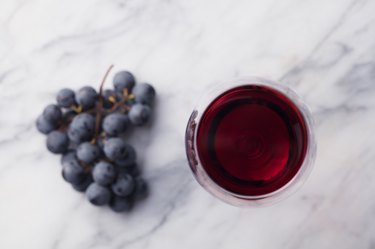
Vanilla or chocolate, Coke or Pepsi, dry or sweet: You may have strong preferences when it comes to these kinds of choices. Someone who loves dry red wine doesn't want to pop the cork on a new bottle and find that it's as sweet as candy. Luckily, finding dry red wines is hardly a challenge. In fact, a bigger problem when looking for the driest red wine types might be the overwhelming number of options available at your local wine shop.
Understanding Dryness in Wines
Video of the Day
When you hear someone describe a wine as dry, generally, that simply means that it's not sweet. Someone who is not super familiar with wine might find it hard to distinguish between one that's very dry and one that's sweeter, but regular wine drinkers tend to have strong preferences for dry wines over sweet wines or vice versa.
Video of the Day
In technical terms, dry wines have no residual sugar; that is, all of the sugar that's in the grapes is converted to alcohol during the fermentation process. Sweet wines are made by stopping fermentation early, leaving some of that sugar in the wine. This is why you may also see wines described as semidry or semisweet. Different producers leave different amounts of residual sugar in their wines, resulting in a wide range of possibilities along the sweetness spectrum.
Even among wines with no residual sugars, some create more of a puckering dryness in the mouth than others. This sensation is caused by tannins, a kind of compound found in the skins, seeds and stems of grapes. So, when wine drinkers look for the very dry red wines, they're generally looking for varietals that have no residual sugars and a high concentration of tannins.
The Driest Red Wine Types
Wine preference is personal, and two people may detect very different notes from the same wine. Plus, because the dryness of a particular wine depends on how that specific winery chose to time the fermentation process, there can be a lot of variety within one varietal. One brand of syrah may be tartly dry, while the brand next to it is noticeably sweet, for example.
That said, cabernet sauvignon is probably at the top of the driest red wines list. It's naturally high in tannins and tends to be bold and full-bodied. Sangiovese, merlot and pinot noir are also red wine varietals that are generally on the dry side. Zinfandel can be quite dry, but it can also be quite sweet, so check the label carefully before committing to a zin.
Red Wines to Avoid
Red wines are generally more likely to be on the dry side than whites, but some varietals are crafted to be sugary sweet. Any red that is advertised as being "fruit forward" will generally have some notes of sweetness. Steer clear of red moscato wines, lambrusco and port. Certainly, anything labeled as a dessert wine has no place on the driest red wines list.
Tips for Choosing Dry Red Wine
When it comes to choosing a specific bottle in a store, the best way to find one that suits your preferences is to ask an associate for helping choosing one that's very dry. This is especially useful because so many wonderful red wines are now made of grape blends that might not be on your radar. If you're looking only at bottles of cabernet sauvignon or merlot, for example, you'll miss a lot of the good options available.
Also, consider loading a wine app on your phone before shopping. Look for an app that provides personalized recommendations or lets you scan bottles in the store to get more information before buying.